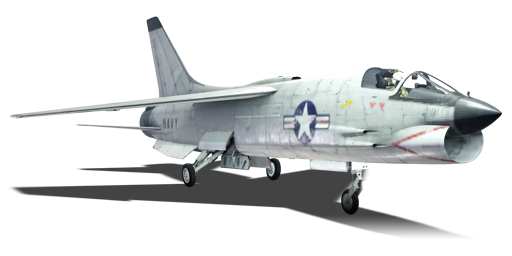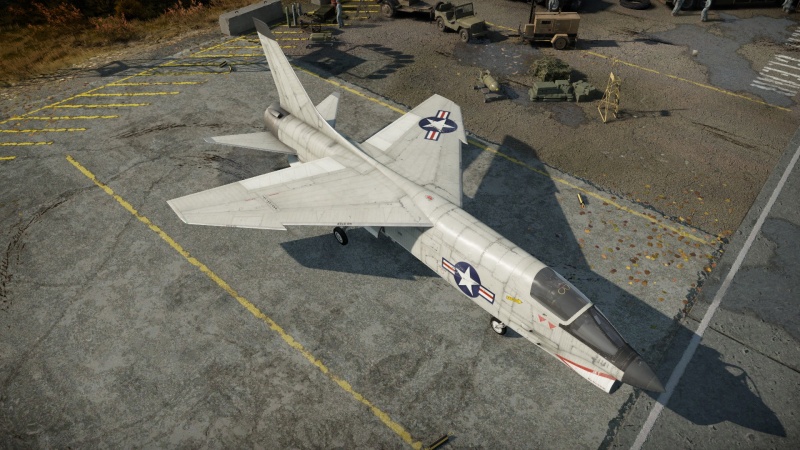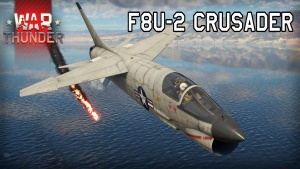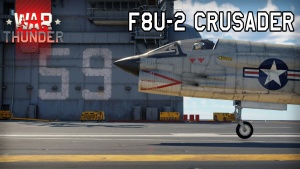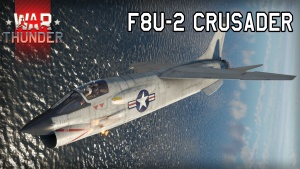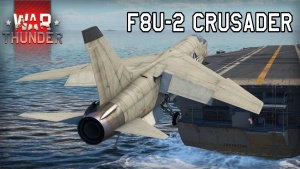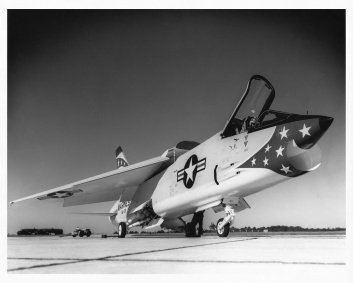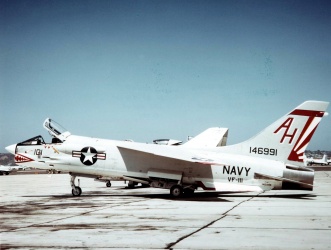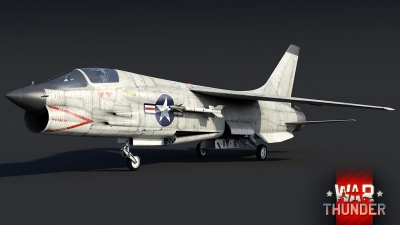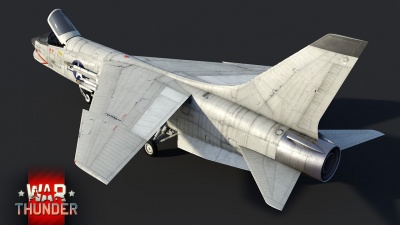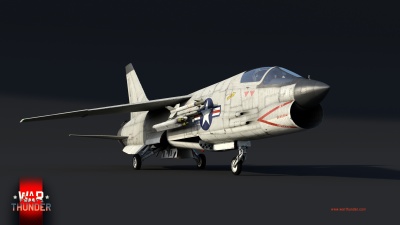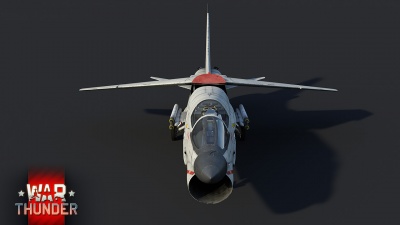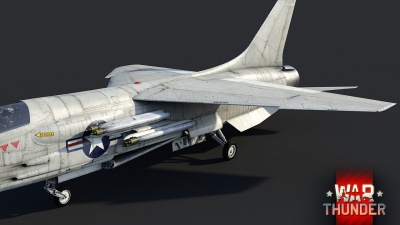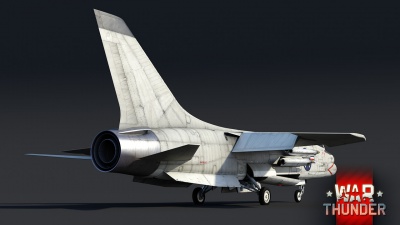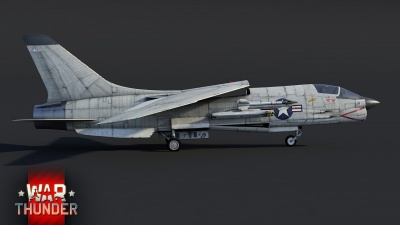F8U-2
Contents
Description
The F8U-2 Crusader II is a rank VI American jet fighter with a battle rating of 9.7 (AB), 10.3 (RB), and 10.0 (SB). It was introduced in Update "Ixwa Strike".
General info
Flight performance
The F8U-2 is a single engine supersonic carrier-based jet fighter, its powerplant is the Pratt & Whitney J57-P-16 engine that can produce 8,000 kgf of thrust. The Crusader is able to reach 1 Mach in level flight at sea level and 1.95 Mach at 10,600 m, that puts it on par with many jet fighters like the MiG-19 or the Su-7B, but it is also slower than any F-104 and MiG-21 at low altitude. The structural speed limit is very high: 1,555 km/h IAS, reaching that speed even when the plane is diving is not that easy, so the player does not have to worry about overspeeding. Its thrust to weight ratio while not being close to 1.0 still is good enough to make the plane very good in any longer fight and makes the level acceleration very good. The F8U-2 is also decent at climbing, at sea level with full fuel tanks it can reach up to 130 m/s, however other jets like the MiG-19, MiG-21, or Su-7 are better at climbing. With the afterburner on and full fuel tanks it can fly for about 12 minutes at low altitude, flying at higher altitude (5,000 m) increases it to about 16 minutes.
Compared to many other supersonic jet fighters, the Crusader is very good at dogfighting. Although it has quite low G limits (+10G with full fuel tanks) it is capable in both shorter and longer fights because of instantaneous turn rate which can be improved by using slats with the speed limit that is 1,070 km/h IAS (slats which are not automatic are being extended by switching flaps to the combat position, also the flaps itself are being extended after switching them to the landing position) and sustained turn rate, the plane is capable of performing a full horizontal circle at sea level in 22 seconds with 30 minutes of fuel. The best sustained turn rate can be achieved by flying at ~650 km/h IAS where it reaches 16.2 deg/s, that makes it better at longer turning than many jet fighters, for example any MiG-21, Mirage, F-4 Phantom or F3H, however it will struggle below 300 km/h against anything because of high wing loading. Due to low G limits the plane is very easy to break in RB with the Mouse Aim controls, in SB it also the case, especially after switching to the damping stability augmentation system (SAS) mode, which overrides high speed locking of the elevator. The roll rate performance is above the average compared to other jet fighters, it is ~135 deg/s at 600 km/h IAS and increases further to ~210 deg/s at 1,000 km/h IAS. The airbrake in this plane is located under the fuselage, that means it is not possible to extend it and the landing gear at the same time. The most interesting feature about this plane is its variable-incidence wing design which can be pivoted by 7° out of the fuselage during the take-off or landing to make them easier, this functionality can be enabled by lowering flaps to the landing position and the minimum speed is 580 km/h IAS.
With full-real controls the F8U-2 has access to two SAS modes, manual and damping. With the manual mode it is quite challenging to fly, it is very easy to pull too much G or stall it out at lower speed. After switching to the damping mode it gets much more stable, but gets less responsive in roll axis, also makes the plane not lock up at any speed.
| Characteristics | Max Speed (km/h at 10,668 m) |
Max altitude (metres) |
Turn time (seconds) |
Rate of climb (metres/second) |
Take-off run (metres) | |||
|---|---|---|---|---|---|---|---|---|
| AB | RB | AB | RB | AB | RB | |||
| Stock | 2,025 | 2,017 | 16310 | 28.4 | 29.4 | 113.8 | 104.6 | 1,828 |
| Upgraded | 2,054 | 2,038 | 27.6 | 28.0 | 162.5 | 137.0 | ||
Details
| Features | |||||
|---|---|---|---|---|---|
| Combat flaps | Take-off flaps | Landing flaps | Air brakes | Arrestor gear | Drogue chute |
| ✓ | X | ✓ | ✓ | ✓ | X |
| Limits | ||||||
|---|---|---|---|---|---|---|
| Wings (km/h) | Gear (km/h) | Flaps (km/h) | Max Static G | |||
| Combat | Take-off | Landing | + | - | ||
| 1555 | 428 | 1070 | N/A | 583 | ~10 | ~6 |
| Optimal velocities (km/h) | |||
|---|---|---|---|
| Ailerons | Rudder | Elevators | Radiator |
| < 1000 | < 590 | < 500 | N/A |
Engine performance
| Engine | Aircraft mass | |||||||
|---|---|---|---|---|---|---|---|---|
| Engine name | Number | Basic mass | Wing loading (full fuel) | |||||
| Pratt & Whitney J57-P-16 | 1 | 8,339 kg | 341 kg/m2 | |||||
| Engine characteristics | Mass with fuel (no weapons load) | Max Takeoff Weight | ||||||
| Weight (each) | Type | 14m fuel | 20m fuel | 30m fuel | 45m fuel | 48m fuel | ||
| 1,592 kg | Afterburning axial-flow turbojet | 9,531 kg | 9,916 kg | 10,708 kg | 11,925 kg | 12,279 kg | 12,760 kg | |
| Maximum engine thrust @ 0 m (RB / SB) | Thrust to weight ratio @ 0 m (WEP) | |||||||
| Condition | 100% | WEP | 14m fuel | 20m fuel | 30m fuel | 45m fuel | 49m fuel | MTOW |
| Stationary | 4,562 kgf | 8,003 kgf | 0.84 | 0.81 | 0.75 | 0.67 | 0.65 | 0.63 |
| Optimal | 4,804 kgf (1,000 km/h) |
8,921 kgf (1,200 km/h) |
0.94 | 0.90 | 0.83 | 0.75 | 0.73 | 0.70 |
Survivability and armour
The only protection that this plane offers is a 25 mm bulletproof glass in front of the cockpit. Fuel tanks are located in the center part of the plane: in the fuselage and wings, getting hit there will most likely set the plane on fire. Flaps in this plane work also as ailerons, so losing them by overspeeding or being hit will make the plane unable to roll.
Modifications and economy
Armaments
Offensive armament
The F8U-2 is armed with:
- A choice between two presets:
- 4 x 20 mm Browning-Colt Mk12 Mod 3 cannons, nose-mounted (144 rpg = 576 total)
- 4 x 20 mm Browning-Colt Mk12 Mod 3 cannons, nose-mounted (144 rpg = 576 total) + 32 x FFAR Mighty Mouse rockets
Suspended armament
The F8U-2 can be outfitted with the following ordnance:
- Without load
- 2 x AIM-9B Sidewinder missiles
- 4 x AIM-9B Sidewinder missiles
- 2 x AIM-9D Sidewinder missiles
- 4 x AIM-9D Sidewinder missiles
- 4 x Zuni Mk32 Mod 0 ATAP rockets
- 8 x Zuni Mk32 Mod 0 ATAP rockets
- 2 x AIM-9B Sidewinder missiles + 4 x Zuni Mk32 Mod 0 ATAP rockets
- 2 x AIM-9D Sidewinder missiles + 4 x Zuni Mk32 Mod 0 ATAP rockets
Usage in battles
It is recommended to first climb to above 4,000 m in a battle, especially when the enemies do not have any radar-guided missiles. This way, the fragile flight characteristics of the Crusader can be compensated since it is impossible to pull more than 8Gs at such altitude.
When at a high altitude, use Boom-and-Zoom tactics and fire your AIM-9Ds at enemies under you. As it now has a maximum overload of 18G and no launch overload limitation, AIM-9Ds should be sufficient for defeating at least two enemy planes in a run. The best distance for using these missiles is about 3 km, as it has the longest power stage of all IR missiles in game, and your enemy would be less likely to notice the missile at longer range.
As the F8U-2 has a great energy retention and good manoeuvring characteristics, it is recommended to engage enemies in a dogfight. Just pay attention to the speed, as the F8U-2's wing could be easily ripped when pulling high Gs. When dogfighting, you can avoid extreme overload by either lowering your speed to below 900 km/h or by climb to a higher altitude.
The enemies worth noting are:
- A5Cs, Jaguar As, French F8Es and Mirages, since it is almost impossible for the F8U-2 to dodge the R-550 Magic missiles at high speed, even with countermeasures equipped.
- Soviet aircraft with R-60 missiles, since the only way of dodging this missile is by using flares.
- Other American aircraft with AIM-9Gs and -9Js, for the same reason as above.
- MiG-17s, as they can and will outmanoeuvre you in a dogfight.
SB EC
The F8U-2 is a great dogfighter, it can deal with almost any fighter in EC7 bracket, its main strengths are very good sustained turn rate, radar with an identification friend or foe feature and quite good missiles: the AIM-9D. Before spawning in it is the best to select 30 or 45 minutes of fuel, its consumption is very high in combat and it is very easy to run out of it after fighting multiple enemies. Due to the presence of radar guided missiles and the lack of any countermeasures or systems like the RWR it is recommended to not fly too high, flying even at very lot altitude will work because of the excellent turning capabilities of the Crusader.
Compared to the other jet fighters at a similar battle rating, the F8U-2 has similar low-altitude level speed, and planes like the MiG-21, Mirage III, J35, Lightning F.6 or F-104 will easily be able to outclimb or outrun it. However all of them can easily be outturned, any delta wing jet will struggle in sustained turning, even the MiG-21bis with a very high thrust to weight ratio. Since the F8U-2 has quite high wing loading and the fact it is very easy to break wings, going for scissors should be avoided. Flying at low speed (below 400 km/h) also will end up badly.
The best sustained turn rate can be achieved by flying with the speed range: 550 to 740 km/h, its turn rate will be ~16°/s without missiles and 30 min of fuel and 15 deg/s with missiles and the same fuel amount. The most dangerous delta wing plane, the MiG-21bis is worse by 1-2°/s and the other MiGs like the MF and earlier by 3-4°/s. Other planes like the Mirage or J35 are similar to the MiG-21MF, so outturning them should not be a problem, however the Mirage is equipped with the R.550 missile which can be launched from quite high angles and can pull up to 30G, so it is the best to not allow it to get anywhere near the rear of the F8U, the later MiG-21 versions can also carry a similar missile, the R-60M, which is very dangerous at close range within 2,000 m.
The most dangerous foes that this plane can meet are the MiG-19 and J32B, both are better at dogfighting and as fast as the Crusader at low altitude, engaging them without the speed and altitude advantage is not recommended, although since they carry very early missiles, the R-3S and AIM-9B, it is possible to just run away from them and easily dodge their missiles, but that will work only above 2,000 m. Both these fighters are better at sustained turning by at least 20%, their wing loading is also lower, so forcing them to one circle fight/scissors might be risky.
The last plane worth mentioning is the Su-17M2, its sustained turn rate is also superior to the F8U, but since its wing loading and stall speed are so much higher it can be forced to low speed or one circle fight, it also does not have any radar except for the rangefinding one for its gun. All weapons used by that plane are very similar to the MiG-21Bis, so running away will not end well, it is also one of the fastest planes.
Radars
The F8U-2 is equipped with an AN/APQ-50 search and tracking radar. The radar is mounted in the nose of the aircraft.
| AN/APQ-50 - Target Detection Radar | |||
|---|---|---|---|
| Maximum Detection Range |
Guaranteed Detection Range |
Max Azimuth Scan Angle |
Max Elevation Scan Angle |
| 370,000 m (theoretical) |
40,000 m | ±50.0° | -8.15°/+4.15° |
| AN/APQ-50 - Target Tracking Radar | |||
| Maximum Tracking Range |
Minimum Tracking Range |
Azimuth Tracking Angle |
Elevation Tracking Angle |
| 92,500 m | 200 m | ±58.0° | ±58.0° |
Pros and cons
Pros:
- Cannons could fire separately to save ammo
- Cannons can deal serious damage, with 4 guns even a short burst is enough to destroy an enemy aircraft.
- Four AIM-9Ds, good when engaging enemies at about 3 km
- Excellent flight performance
- Superb acceleration, even compared to top tier jets
- Very stable, even at high speed
- Very good sustained turn rate
- Landing flaps provide a lot of lift thanks to the variable wing design
- Extendable rocket pod which fires 16 Mighty Mouses at once
- Good radar with an identification friend or foe feature
Cons:
- Fragile wings, can easily rip at high speeds and hard turns.
- Very likely to set on fire because of the fuel tank placement
- Lacks RWR
History
In the early 1950s, the US Air Force and US Navy both realized that with the arrival of the supersonic age, they both needed to develop new fighters to meet the new challenges in the mid and late 1950s. The US Air Force's answer was the North American Aviation Sabre-45 program, this program would be later developed into the famous F-100 Super Sabre that entered service in 1954. But by contrast with the US Air Force, the birth of the first supersonic fighter of the US Navy was much more complicated.
In July 1952, Chance Vought leadership learned that there would be a competition for a simple, lightweight, low-cost day fighter with a maximum speed of Mach 1.0 (670 mph). During the first week of September 1952, Chance Vought's general manager Detweiler met Captain Russel in the chief of naval operations section and discussed the day fighter specifications. As for the result, Detweiler said that he preferred the twin-engine design and the Bureau of Aeronautics (BuAer) was prepared to go ahead with a lightweight refinement of the Westinghouse J46 engine.
On 16th September 1952, the BuAer invited Chance Vought to submit proposals for a new Navy day fighter with special emphasis placed on simplicity, small size, low cost, and a maximum speed of Mach 1. This request for proposals was based on Outline Specification 130 (OS-130) which has often been regarded as the true beginning of the Chance Vought F8U. In general, the Navy wanted a fighter that could maintain air superiority in daylight and fair weather, both over friendly task forces and hostile areas. OS-130 specified a maximum speed of at least Mach 1 at 35,000 feet in level flight at combat weight, the combat radius was to be not less than 300 nautical miles, an altitude of 52,000 feet was the specified combat ceiling at maximum power with a combat load (fuel and weapons).
At the initial stages, Chance Vought's engineers preferred the twin-engine design, but a single-engine proposal was also put forward as a backup choice, and the powerplant that was chosen was the Wright J65 engine, a license-produced version of the British Armstrong Siddeley Sapphire engine. However, on 31st October 1952, a letter written by Paul Baker to Detweiler suggested that the single J65 engine design couldn't meet the required specification of the OS-130 program, and he recommended the newly developing Pratt Whitney J57 engine for replacement, as well as suggesting a variable-incidence swept wing with a tail configuration. In December 1952, twelve basic configurations was studied by Chance Vought's engineers including six configurations with a variable incidence feature on the wings and six configurations without.
But on 18th November 1952, the BuAer changed some required specifications of the OS-130 day fighter program including the maximum speed, which was increased from Mach 1 to Mach 1.2 at an altitude of 35,000 feet with thrust augmentation, and the Pratt Whitney J57-P-7 engine was chosen to be the only engine that could deliver an airplane to meet or exceed all requirements, the estimated landing speed was 145 to 160 knots depending on the wing area of the design. Also on 29th December 1952, amendment 3 released by the BuAer to the OS-130 program restricted catapulting and arresting accelerations to 5.5G. With the incorporation of these changes and wind tunnel test results, Chance Vought finally had a configuration for their day fighter proposal, the V-380, and the first engineering report of V-380 Navy day fighter was published to the BuAer on 5th September 1953.
To meet the new specification, Chance Vought proposed two aircraft: one maximum performance with the J57 engine and one minimum performance with the J65 engine, both with afterburners, these two proposals were divided from the original V-380 program and were called V-383 and V-384 program. At this stage, the basic weapon configuration for these two programs were sixty 2-inch rockets and three T-160 20 mm cannons, they both had the same variable-incidence wing design. On 19th May 1953, the V-383 proposal was selected by BuAer and a contract was rewarded by Chance Vought for the test of the V-383 proposal, now officially designated XF8U-1.
The first XF8U-1 prototype was delivered to the structures test lab at 7:42 am on 19th February 1955, and during the first flight mission on 25th March 1955, the XF8U-1 prototype with J57-P-11 engine successfully achieved the object of flight speed of Mach 1.1, which was six days ahead of contract schedule and only 22 months from the contract between the US Navy and Chance Vought. After some technical changes of the XF8U-1 prototype, the first production model of F8U-1 began to roll off the Dallas assembly line and successfully completed its first flight mission on 30th September 1955 which was only six months after the first flight of the XF8U-1 prototype.
The first 30 F8U-1s were equipped with a J57-P-12 engine while the later version was equipped with a new J57-P-4 engine which could produce 16,000 lbs of thrust in afterburner mode; the first 30 F8U-1s were retrofitted with new J57-P-4 engines later. The maximum level flight speed of the F8U-1 was nearly Mach 1.5, the basic weapon configuration of F8U-1 was four Colt Mk.12 20 mm cannons with 576 rounds in total and a retractable rocket launcher under the fuselage with twenty-four 2.75 inch Mighty Mouse rockets in total. Apart from that, since the new AIM-9B Sidewinder infrared-guided short-range air-to-air missile was entered into service in 1956, Chance Vought also introduced this new-generation weapon onto F8U-1 which later could carry two Sidewinder missiles in total.
The F8U-1 was equipped with Mk 16 Mod 12 Aircraft Fire Control System including an AN/APG-56 ranging radar (a modified AN/APG-30A ranging radar), this was inferior to the F-100 Super Sabre of USAF in the same period because the US Navy didn't purchase the A-1 or A-4 gun/rocket/bomb calculating gunsight like the USAF, also the only role for the F8U-1 was air superiority missions. The ranging radar system could lock onto any target within range and furnish target information to the fire-control system for gun firing, also the fire control system may be used in conjunction with Sidewinder missile launching. In this case, the missile release indicator displayed optimum missile launching point.
In September 1955, the US Navy decided that all its carrier aircraft needed to be equipped for aerial refuelling. Since the internal space of F8U-1 was already tight with the incorporation of all necessary equipment into the smallest airframe possible for the day competition, Chance Vought decided to install a retractable air-refuelling probe, and the 16th F8U-1 was modified and took place in test program from December 1956 to the end of March 1957. After the test program was finished, since the 50th (another source claim the 66th) production aircraft the In-flight refuel (IFR) ability was added into F8U-1, and the earlier F8U-1s were retrofitted with refuelling probes too. Apart from that, Chance Vought also tested the Boundary Layer Control System (BLC, the first test of BLC system was conducted in the 100th production F9F-4 and was first introduced in F-104A Starfighter) in the sixth F8U-1, and the Boundary Layer Control System was finally introduced into the French Navy F-8E(FN) and American F-8J Crusader (a modernization version of F-8E) in the 1960s.
After the carrier qualifications aboard USS Forrestal in April 1956, the F8U-1s began to come off the assembly line at a rate of eight per month, and VF-32 squadron at NAS Cecil Field became the first combat unit to receive the new F8U-1 in March 1957. It was named Crusader in August 1955 by Detweiler, which was a name that would became a truly nightmare for all MiG pilots. On 21st August 1956, Windsor successfully flew the 15th production F8U-1 Crusader to set a new speed record of 1,015 mph, breaking the previous record of 822 mph held by USAF's F-100C Super Sabre under the name of Project One Grand. This achievement helped him and the Crusader earned the highly prized Thompson trophy. The final F8U-1 came off the production line in 1961 and its name was changed to F-8A in 1962. The total amount of F8U-1 Crusaders to come off the production line was 317.
The second production version of the Crusader which entered into US Navy service was the F8U-1E. The most important change for the F8U-1E compared to the original F8U-1 was the new AN/AWG-3 Fire Control system including AN/APS-67 Search and Range-tracking Radar and a computer group to provide a limited all-weather capability for the Crusader, the computer group used the target range and range rate information from the AN/APS-67 radar to generate a lead angle which was presented to the pilot as gunsight pipper displacement. The prototype of the F8U-1E first flew in 3rd September 1958 and 130 F8U-1Es were produced in total. It was renamed F-8B in 1962.
In the 1960s, the F-8B became the first version of the Crusader family to integrate the new AIM-9D Sidewinder missile which was introduced into service in 1966 (F-8A didn't have provision for the AIM-9D Sidewinder missile). Cooling nitrogen was added to the launcher to permit the use of AIM-9D Sidewinder missile on F-8B Crusader.
On 29th April 1954, a recommendation of BuAer extended the current 5 basic configuration F8U-1 to 75 with an additional 34 being produced out of FY 1956, and an F8U-2 designation would be given to the new version with several new equipment such as Sidewinder missile and in-flight refuel probe etc. Though it was scheduled that 59 F8U-2 would be built from the remaining FY 1956 budget, this decision was be abandoned by BuAer in October 1955.
In the summer of 1957, the new F8U-2 project was born. The most important change for the new F8U-2 was the Pratt Whitney J57-P-16 engine which replaced the J57-P-4 engine used by F8U-1 and F8U-1E, the new engine could produce 16,900 pound thrust in afterburner mode compared to the former's 16,000 pound maximum thrust in afterburner mode, this improvement increased the maximum level flight speed of F8U-2 to Mach 1.95 and the maximum climb rate at sea level to 200 m/s. Other improvements including low aspect ratio ventral stabilizing fins installed on the lower rear fuselage for additional stability in the extended flight boundary region, external cooling air scoops for added cooling for the afterburner section as well as for increase afterburner thrust due to better air flow characteristics were also introduced into F8U-2, also the AN/AWG-3 fire control system was remained in F8U-2 too.
Apart from that, Chance Vought also introduced the new "Y" type missile racks that permitted the installation of four AIM-9 Sidewinder missiles (two on each rack) on F8U-2 Crusader which doubled the firepower. Also in the 1950s, the Swiss Air Force once showed interest on F8U-2 and sent pilots to flew the F8U-2 at the Naval Air Test Center, Patuxent River and the delivery was scheduled in February 1959, but the Swiss changed their mind to purchase French Mirage IIIs in the end. JASDF once reviewed the F8U-2 but they chose the Lockheed F-104 Starfighter in the end too. The Swordsman Squadron (VF-32) become the first navy unit to receive the new Crusader on March 25th, 1957 and they soon joined the USS Saratoga's first Mediterranean cruise. During the carrier's duties in the 1958 Lebanon crisis, the Swordsman's Crusaders provided air cover for the Marine Corps' landing in Beirut. In 1962, the designation of F8U-2 was changed to F-8C Crusader, and during the Vietnam War, F-8C Crusader flew combat missions by both the US Navy and US Marine Corps, where the Navy's F-8C Crusader scored six air-to-air kills including five MiG-17 and one MiG-21. (Another source claimed five air-to-air kills in total including four MiG-17 and one MiG-21).
Devblog
In 1952, the American Naval command announced requirements for a new supersonic jet carrier-based fighter to protect carrier groups from enemy aircraft and achieve air superiority. Chance Vought Aircraft Inc., which already had considerable experience working with carrier-based aircraft, became one of the participants in the competition. Their candidate differed from the competition by a variable-incidence wing. The wing tilted upward by 5 degrees, which noticeably improved taking off and landings on short decks of aircraft carriers.
Just 20 months after receiving the contract, the first prototype was built for tests. The fighter successfully passed the initial tests, in the very first flight it easily broke the sound barrier, and in a modified form went to the navy for deck tests. The first prototype series was successfully tested on aircraft carriers in the spring of 1956, after which the F8U-1 Crusader entered service with the US Navy. Work on a promising jet fighter did not stop after the start of mass production. The modified aircraft with a new power plant, advanced navigation system, radar, FCS and improved armament received the designation F8U-2.
The Crusader has become a real legend and a symbol of US carrier-based aviation for its excellent flight characteristics, ease of operation, reliability and significant firepower. The fighter received the baptism of fire almost immediately after entering the service, and since then has been actively used in combat and training missions in many parts of the world, including intensive combat service in Vietnam. Even when more advanced aircraft entered service, the naval pilots were reluctant to say goodbye to the Crusaders. "When you're out of F-8's, you're out of fighters" they said.
Media
- Skins
- Images
See also
- Aircraft of comparable role, configuration and era
- Mitsubishi T-2
- Mikoyan-Gurevich MiG-19
- Mikoyan-Gurevich MiG-21
- Hawker Hunter F.6
- Fiat G.91 YS
- Saab J32B
External links
- [Devblog] F8U-2 Crusader: The Last of the Gunfighters
- Official data sheet - more details about the performance
- [Royal Aeronautical Society] An Examination of the F-8 Crusader through Archival Sources
| Chance Vought Aircraft | |
|---|---|
| Fighters | |
| Corsair | F4U-1A · F4U-1A (USMC) · F4U-1C · F4U-1D · F4U-4 · F4U-4B · F4U-4B VMF-214 |
| Float planes | O3U-1 · OS2U-1 · OS2U-3 |
| Attackers | AU-1 |
| Bombers | SB2U-2 · SB2U-3 |
| Jet aircraft | |
| Corsair II | A-7D · A-7E · A-7K |
| Crusader | F8U-2 · F-8E |
| Export | V-156-B1 · V-156-F · ▄Corsair F Mk II · F4U-7 · ▄F-8E(FN) |
| Captured | ▅F4U-1A |
| USA jet aircraft | |
|---|---|
| Fighters | |
| F9F | F9F-2 · F9F-5 · F9F-8 |
| F-80 | F-80A-5 · F-80C-10 |
| F-84 | F-84B-26 · F-84F · F-84G-21-RE |
| F-86 | F-86A-5 · F-86F-25 · F-86F-2 · F-86F-35 |
| F-89 | F-89B · F-89D |
| F-100 | F-100D |
| F-104 | F-104A · F-104C |
| F-4 | F-4C Phantom II · F-4E Phantom II · F-4J Phantom II · F-4S Phantom II |
| F-5 | F-5A · F-5C · F-5E · F-20A |
| F-8 | F8U-2 · F-8E |
| F-14 | F-14A Early · ▄F-14A IRIAF · F-14B |
| F-15 | F-15A · F-15C MSIP II · F-15E |
| F-16 | F-16A · F-16A ADF · F-16C |
| Other | P-59A · F2H-2 · F3D-1 · F3H-2 · F4D-1 · F11F-1 |
| Strike Aircraft | |
| FJ-4 | FJ-4B · FJ-4B VMF-232 |
| A-4 | A-4B · A-4E Early |
| A-7 | A-7D · A-7E · A-7K |
| AV-8 | AV-8A · AV-8C · AV-8B Plus · AV-8B (NA) |
| A-10 | A-10A · A-10A Late · A-10C |
| F-111 | F-111A · F-111F |
| Other | A-6E TRAM · F-105D · F-117 |
| Bombers | |
| B-57 | B-57A · B-57B |


